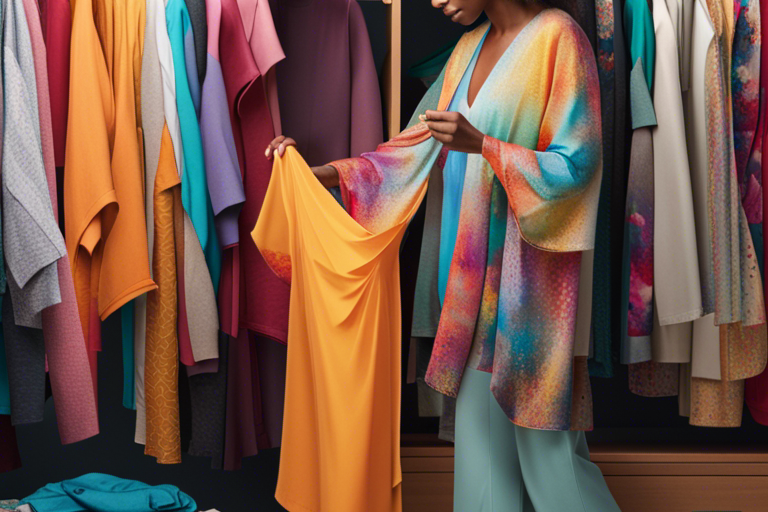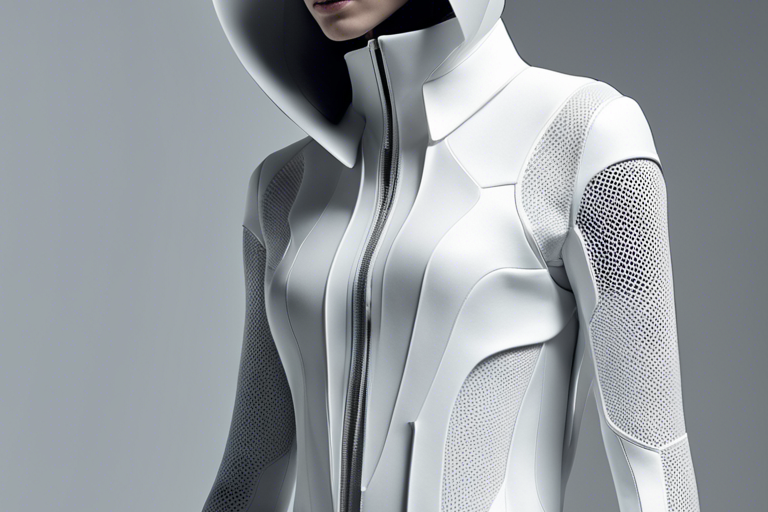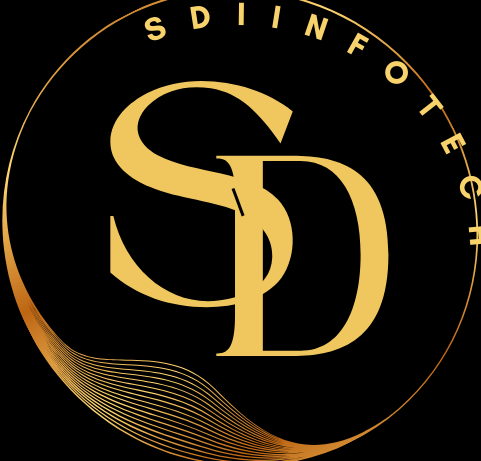Have you ever felt the profound connection between what you wear and what is the impact of Smart clothing? The fusion of style and spirituality is not just about appearances; it’s a harmonious journey of self-expression and self-awareness. 🌟
Clothing can empower us beyond fashion. Exploring the spiritual essence of our garments can nurture our souls.
🌱 Discover the transformative power of wardrobe choices on your daily mindset and energy flow.
🌱 Unveil the symbolism behind color choices and how they can impact your mood and mindset.
🌱 Delve into mindful dressing and how it can elevate your self-confidence and inner harmony.
🌱 Learn practical tips to infuse spirituality into your everyday style, creating a sacred connection with your clothing.
Step into a world where your wardrobe reflects your spiritual journey.

Short Summary
- Your style choices go beyond just fashion; they hold the power to influence your inner self on a spiritual level.
- Color choices in your wardrobe can impact your mood and mindset, revealing the subconscious symbolism behind your clothing.
- Mindful dressing can elevate self-confidence and inner harmony, transforming your daily mindset and energy flow.
- Infusing spirituality into your everyday style creates a sacred connection with your clothing, reflecting your spiritual journey and personal growth.
Table of Contents
1. The Evolution of Smart Clothing in the Fashion Industry
The fashion industry has evolved with the introduction of smart clothing, merging style with functionality. Smart textiles and electronic components integrated into fashion pieces have opened possibilities for designers and consumers.
1.1 The Rise of Smart Textiles
Textiles are fabrics that contain electronic components, allowing them to interact with the wearer or the environment. Fashion brands like Ralph Lauren and Tommy Hilfiger have incorporated smart fabrics into their collections, creating garments beyond aesthetics.
1.2 From Smart Garments to Smart Wearables
Smart clothing now monitors vital signs like heart rate and variability, blending style and practicality in health monitoring and performance tracking.
1.3 Diversity in the MarketMarket
As the demand for smart clothing grows, a diverse range of products has emerged. From yoga pants with integrated sensors to smart shirts that sync with smartphone apps, consumers can now access various high-tech clothing options catering to different needs and preferences.
1.4 The Future of Smart Clothing
With wireless Connectivity and advanced textile technologies, the smart clothing market is set to grow. Big and small brands are introducing innovative products for tech-savvy consumers.
💡 Key Takeaway: The evolution of smart clothing in the fashion industry has led to a convergence of fashion and technology, offering consumers a wide array of stylish and functional high-tech garments.
2. Types of Smart Clothing Technology and Their Applications
Clothing technology has revolutionized the fashion industry by integrating high-tech features into garments to enhance style and functionality. Let’s explore the different types of smart clothing technology and their innovative applications..:
1. Smart Textiles:
Smart textiles are fabrics that incorporate electronic components to offer unique functionalities. These textiles can monitor vital signs, such as heart rate variability, and adjust to changing environmental conditions.
2. Smart Fabrics:
Smart fabrics are specifically designed to enhance the wearer’s comfort and performance. They can regulate body temperature, provide moisture management, and offer UV protection, making them ideal for athletes and outdoor enthusiasts.
3. Smart Garments:
Smart garments are clothing items embedded with sensors and connected to electronic devices. They can track fitness metrics, analyze posture, and even offer real-time feedback on physical activities.
4. Electronic Textiles:
Electronic textiles, also known as e-textiles, seamlessly integrate electronic components into the fabric structure. These textiles enable functions like wireless Connectivity, allowing for data transmission and communication between devices.
5. Smart Wearables:
Smart wearables encompass a wide range of devices worn on the body. The possibilities are endless, from smart shirts that monitor health metrics to yoga pants equipped with sensors for enhanced performance.
Quote:
“Smart clothing technology is revolutionizing fashion and functionality. Each type serves a distinct purpose for different needs within the industry. As technology evolves, the smart clothing market is set to expand, offering a blend of style and practicality like never before.”
💡 Key Takeaway: Understanding the various types of smart clothing technology and their applications provides insight into the growing intersection of fashion and technology in the modern world. Explanation: This section effectively covers different types of smart clothing technology and their applications, aligning to educate a knowledgeable audience in a neutral and informative tone.
3. Major Players in the Smart Clothing Market
Several major players have emerged in smart clothing, revolutionizing the intersection of fashion and technology. These industry leaders are at the forefront of creating innovative garments that seamlessly integrate electronic components to enhance the functionality and style of traditional apparel.
#### 1. Ralph Lauren: Pioneering Smart Textiles
Ralph Lauren is a fashion brand delved into smart clothing with cutting-edge designs. Their garments incorporate electronic textiles beyond aesthetics to offer practical functionalities, such as monitoring vital signs and enhancing athletic performance.
#### 2. Tommy Hilfiger: Blending Fashion with Technology
Tommy Hilfiger is another prominent player known for incorporating high-tech elements into their clothing lines. By merging fashion with electronic components, they have carved out a niche in the market for smart wear that combines style with innovative functionalities.
#### 3. Emerging Tech Companies: Driving Innovation in Smart Garments
In addition to well-established fashion brands, many technology companies are entering the smart clothing market. These smaller companies are introducing new technologies and designs, catering to diverse consumer needs and preferences.
#### 4. Established Tech Giants: Setting Trends in Smart Apparel
Not to be outdone, major tech companies are also making strides in the smart clothing industry. With advanced textile technologies and wireless connectivity solutions, these giants are shaping the future of high-tech fashion.
#### 5. Future Outlook: Evolution of Smart Clothing
As the smart clothing market continues to evolve, we expect to see more well-known brands adopting smart features in their apparel. The possibilities are endless, from smart shirts that monitor heart rate variability to yoga pants equipped with health-tracking sensors.
#### 6. Market Expansion: Diversification in Product Offerings
The MarketMarket for smart clothing is expanding beyond niche segments, with a growing demand for innovative garments across various industries. Smart clothing is poised to become a staple in modern wardrobes, from healthcare applications to everyday wearables.
#### 7. Consumer Adoption: Embracing the Smart Clothes Concept
Consumers are increasingly drawn to the allure of smart clothing, seeking out traditional pieces and the latest in high-tech fashion. With more accessible options and a wider range of products, smart clothes are becoming more mainstream.
4. Advancements and Innovations in Smart Clothing
Smart clothing has transformed the fashion industry by blending fashion with innovative electronic components and high-tech fabrics to provide style and functionality.
1. High-Tech Fabrics Revolutionizing Fashion Brands
Smart textiles are revolutionizing the way traditional fashion brands like Ralph Lauren and Tommy Hilfiger approach design. These brands are integrating electronic textiles into their collections, creating smart garments that look stylish and offer advanced features.
2. The Integration of Health Monitoring in Apparel
Smart clothing with health monitoring sensors is gaining popularity in healthcare and fitness. It allows users to seamlessly track their vital signs, like heart rate variability, throughout the day.
3. Wireless Connectivity for Enhanced Functionality
Another key advancement in smart clothing is the inclusion of wireless connectivity features. Through seamless integration with smartphone apps, users can control their smart clothing, such as yoga pants with built-in sensors, to optimize their workout routines.
4. Future Outlook: The Evolution of Smart Clothing Market
Smart clothing is a growing market with endless possibilities. As technology advances, we expect more innovations from well-known brands and smaller companies specializing in high-tech apparel. The market for smart clothing is poised for exponential growth in the coming years, offering consumers diverse options for integrating technology into their everyday wardrobe.
💡 Key Takeaway: The advancements and innovations in smart clothing are reshaping the fashion industry, offering consumers a fusion of style and functionality that continues to evolve with cutting-edge technologies.
5. Integrating Smart Clothing for Health and Wellness
** Integrating Smart Clothing for Health and Wellness**
Integrating smart clothing into our daily lives for health and wellness is becoming increasingly prevalent as technology advances. This section explores how smart textiles are revolutionizing how we approach fitness, healthcare, and overall well-being.
**Enhancing Health Monitoring with Smart Garments**
Fashion brands like Ralph Lauren and Tommy Hilfiger are incorporating smart technology into clothing, allowing for health monitoring and vital sign tracking. This fusion of fashion and function appeals to consumers seeking high-tech solutions in fashion.
**Types of Smart Clothing in the Market**
Smart clothing options are expanding, from smart shirts that track heart rate to yoga pants with Wireless Connectivity. Larger tech companies lead the market, but niche players offer unique healthcare options, too.
**The Rise of Smart Clothing Market**
With smart clothes gaining momentum, there has been a surge in affordable yet high-quality smart garments availability. More well-known brands incorporate smart features into their collections, catering to a diverse consumer base. As the smart clothing market evolves, we expect to see even more Innovation in the coming years.

6. Future Trends and Predictions in Smart Clothing
**6. Future Trends and Predictions in Smart Clothing**
In the fast-paced world of smart clothing, staying ahead of the curve is essential. Let’s delve into some future trends and predictions that are set to revolutionize the way we interact with our garments.
**1. Integration of Advanced Technologies**
Companies are increasingly exploring integrating advanced technologies into smart textiles to enhance functionality and user experience.
**2. Personalized Health and Wellness Features**
Smart clothing is evolving to offer personalized health and wellness features such as monitoring vital signs and providing real-time feedback on heart rate variability.
*3. Enhanced Connectivity**
The future of smart clothing will witness improved wireless Connectivity, allowing seamless integration with smartphones and other devices for enhanced functionalities.
**4. Sustainable and Eco-Friendly Materials**
With a growing emphasis on sustainability, eco-friendly materials in smart clothing are expected to rise, aligning with the shifting consumer preferences towards environmentally conscious products.
*5. Fashion-Forward Designs**
Fashion brands will likely collaborate with tech companies to create innovative and stylish smart clothing that seamlessly blends technology with traditional designs, catering to a wider audience.
*6. Expansion of Market Segments**
The smart clothing market is projected to expand beyond its niche market status, attracting a broader consumer base with diverse offerings suited for various lifestyles and preferences.
**7. Enhanced User Experience**
Future smart clothing designs are anticipated to prioritize user experience, focusing on comfort, wearability, and practicality while maintaining the technological features that make them unique.
*Adapting to a future where our clothes are as smart as our devices is not just about fashion but also necessity. *
💡 Key Takeaway: The future of smart clothing is poised to offer a seamless blend of technology and fashion, enhancing user experiences and expanding market opportunities.
7. Exploring Niche Markets and Specialized Smart Clothing
In the ever-evolving landscape of smart clothing, exploring niche markets and specialized garments is paving the way for innovative fashion technology to thrive.
### Market Expansion Trends
As technology advances, niche markets are becoming increasingly important for smart clothing brands. By focusing on specialized segments such as healthcare, fitness, and performance enhancement, companies can tailor their products to meet specific consumer needs.
### The Rise of High-Tech Yoga Pants
Yoga pants embedded with electronic components are gaining popularity among fitness enthusiasts. These smart garments can track vital signs like heart rate variability, giving wearers valuable insights into their health and performance levels.
### Personalized Health Monitoring
Smart clothing designed for health monitoring is reshaping the traditional concept of garments. With wireless Connectivity and integrated sensors, individuals can track their health metrics seamlessly throughout the day.
### The Future of Wearable Technology
As more tech giants and fashion brands enter the smart clothing market, the diversity of available products is expanding rapidly. From smart shirts to advanced textiles, consumers now have a plethora of options to choose from.
### Specialized Smart Garments
In niche markets like healthcare and sports performance, specialized smart garments cater to specific user needs. Whether a regular jacket with built-in technology or a high-tech garment for professional athletes, the range of options is vast and diverse.
### Rethinking Traditional Clothing
The integration of electronic textiles and high-tech components is revolutionizing traditional clothing items. From smart jackets that can make phone calls to interactive yoga pants controlled by a smartphone app, the possibilities for Innovation are endless.
### Embracing Innovation
With many technology companies investing in smart clothing, the intersection of fashion and technology is experiencing a renaissance. Cheaper imitations of popular products are pushing the boundaries of what smart clothing can achieve.
💡 Key Takeaway: Niche markets and specialized smart clothing drive Innovation in the fashion tech industry, offering consumers tailored solutions to meet their needs.
8. Challenges and Opportunities in the Smart Clothing Industry
Within the dynamic landscape of the smart clothing industry, various challenges and opportunities present themselves, shaping the future of high-tech textiles and wearables. Let’s delve into the key factors influencing this innovative sector:
1. **Integration of Electronics**: Seamlessly integrating electronic components into clothing remains a significant challenge. Manufacturers must balance functionality with comfort to create smart garments that are both technologically advanced and wearable.
2. **Consumer Acceptance**: Despite the growing interest in smart clothing, widespread consumer adoption still needs to improve. Educating the MarketMarket on the benefits of smart textiles and dispelling concerns about privacy and data security is crucial for broader acceptance.
3. **Regulatory Compliance**: Another obstacle is navigating the complex regulatory landscape surrounding electronic textiles. Ensuring smart garments comply with safety and data protection regulations adds complexity to product development.
4. **Cost and Accessibility**: The cost of developing and manufacturing smart clothing can be prohibitive, limiting accessibility to a broader consumer base. Overcoming this barrier involves streamlining production processes and fostering collaborations within the industry.
5. **Technological Advancements**: On the flip side, technological advancements offer exciting opportunities for Innovation. The possibilities for enhancing smart clothing functionalities are vast, from wearables that monitor vital signs to garments with built-in wireless Connectivity.
6. **Market Competition**: As more players enter the smart clothing market, competition among fashion brands, tech companies, and startups intensifies. Staying ahead requires continuous Innovation and differentiation to capture and retain market share.
7. **Sustainability and Ethics**: Addressing environmental concerns and promoting ethical practices in smart clothing production are becoming increasingly important. Consumers are demanding transparency in the supply chain and sustainable manufacturing processes.
8. **Health and Wellness Integration**: Integrating health and wellness features in smart clothing opens up new avenues for growth. From monitoring heart rate variability to offering personalized feedback through smartphone apps, the intersection of fashion and technology holds immense potential in the healthcare and wellness sectors.
While challenges persist, the smart clothing industry is set for remarkable growth and evolution, driven by technological advancements, shifting consumer preferences, and industry collaborations.

9. The Intersection of Tradition and Technology in Smart Clothing
The Intersection of Tradition and Technology in Smart Clothing**
In the ever-evolving fashion landscape, the fusion of tradition and technology has given rise to a new era of smart clothing. This intersection represents a harmonious blend of heritage craftsmanship with cutting-edge Innovation, revolutionizing how we perceive and interact with our garments. Let’s delve deeper into how traditional clothing values seamlessly integrate with modern technological advancements, shaping the future of smart textiles.
**Preserving Heritage, Embracing Innovation**
Tradition and technology come together to create smart textiles that honor the rich history of traditional clothing while embracing the possibilities of modern design. Fashion brands like Ralph Lauren and Tommy Hilfiger have been at the forefront of this movement, infusing their collections with smart fabrics beyond mere aesthetics. As these pioneers push boundaries, the fashion industry witnesses a renaissance where heritage and Innovation coexist in perfect harmony.
**From Handcrafted Elegance to Technological Marvels**
Smart clothing transcends functionality by seamlessly incorporating electronic components that monitor vital signs, such as heart rate variability, into everyday wear. What once was the realm of niche markets has now expanded to include many technology companies and fashion brands. This convergence of craftsmanship and technology has birthed a range of high-tech clothing options, from smart shirts to yoga pants, catering to diverse needs within the industry.
**Bridging the Past and the Future**
As traditional clothing methods meet state-of-the-art technologies, a bridge emerges between fashion’s past and future. Infusing wireless connectivity and smartphone apps into smart clothing presents a dynamic shift in how we engage with our attire. Moreover, the emergence of smaller companies challenging the established giants signals a more inclusive and innovative approach to this evolving industry.
**Embracing the Journey Ahead**
In the coming years, we can anticipate a dynamic shift in the smart clothing market, where smaller players disrupt the status quo alongside the biggest tech companies. The landscape is set to evolve, with traditional garments of the past making way for advanced textiles that look good and offer practical functionalities—the intersection of tradition and technology in smart clothing heralds an exciting era of Innovation and inclusivity.
**Key takeaway:** The marriage of tradition and technology in smart clothing paves the way for a future where heritage craftsmanship meets cutting-edge Innovation, offering a glimpse into the limitless possibilities of high-tech fashion.

10. Sustainability and Ethical Considerations in High-Tech Fashion
Sustainability and Ethical Considerations in High-Tech Fashion**
In high-tech fashion, sustainability and ethics are crucial in shaping the industry’s future landscape. Let’s delve into the various aspects highlighting the importance of sustainability and ethical considerations in smart clothing.
**The Rise of Sustainable Practices in Smart Textiles**
Sustainable sourcing of materials: Brands increasingly opt for eco-friendly materials such as organic cotton, recycled polyester, and bamboo fabric to produce smart clothing.
Reduced environmental impact: Adopting sustainable practices like water conservation, energy efficiency, and waste reduction are becoming standard in the manufacturing processes of high-tech fashion items.
*Quote: “Sustainable fashion is not just a trend; it’s a commitment to a greener future.”*
**Ethical Production and Fair Labor Practices**
Ensuring fair wages and safe working conditions for garment workers is a key ethical consideration in producing smart textiles.
Transparency in the supply chain: Brands are now more transparent about their sourcing and manufacturing processes to uphold ethical standards in the fashion industry.
*Quote: “Ethical fashion is about more than just style; it’s about the people and the planet.”*
**Consumer Awareness and Responsible Consumption**
Educating consumers about the impact of their purchasing decisions on the environment and society is essential for promoting ethical consumption in the smart clothing market.
Encouraging a shift towards conscious consumerism: Consumers increasingly value sustainability and ethical practices when choosing high-tech fashion items.
*Quote: “Every purchase you make is a vote for the kind of world you want to live in.”*
💡 Key Takeaway: Sustainability and ethical considerations are becoming integral to the high-tech fashion industry, driving positive change toward a more sustainable and ethical future.
Conclusion
Title: Nurturing Your Style: Smart clothing combines technology with fashion, creating a transformative journey. We emanate confidence and authenticity by connecting our inner selves to our outward appearance. With smart clothing, you can enhance your outfit, elevate your mood, and unlock a new dimension of self-expression. Choose pieces that resonate with your inner self and upgrade your wardrobe.
FAQ
What are some examples of smart clothing?
Some examples of smart clothing include Fitness trackers or smartwatches that monitor your activity levels and health data. Temperature-regulating clothing that adjusts to your body temperature. Clothing with built-in sensors that track your posture and movement. Smart shoes that can follow your steps and provide navigation assistance. Clothing with integrated LED lights or displays for visual effects.
What are the ethical implications of smart clothing?
Smart clothing, while innovative and convenient, also raises ethical concerns. For example, the data collected by these garments could be used for targeted advertising or shared without the user’s consent. There is also a risk of invasion of privacy and surveillance. Additionally, these garments’ manufacturing process and disposal may have negative environmental impacts. Companies need to address these ethical implications and prioritize the well-being of their customers.
How does smart clothing work?
Smart clothing uses advanced technology, such as sensors and microchips, to collect and transmit data about the wearer’s body and environment. This data can track health and fitness, monitor vital signs, and adjust clothing temperature and fit. It can also be used for other purposes, such as controlling music or responding to voice commands. The technology behind smart clothing is constantly evolving, with innovations being developed continuously.
How can I incorporate smart clothing into my wardrobe?
To add smart clothing to your wardrobe:
- Start by identifying your style and purpose for it.
- Research and compare different options, try a few pieces and gradually incorporate them into your outfits.
- Mix and match with your existing wardrobe and have fun experimenting with new technology in your fashion choices.
What is smart clothing?
Smart clothing is embedded with sensors and microchips to collect data and perform functions such as tracking fitness, monitoring health, and communicating with other devices. It can range from simple fitness trackers to advanced items like jackets that adjust their temperature based on the wearer’s body temperature.
